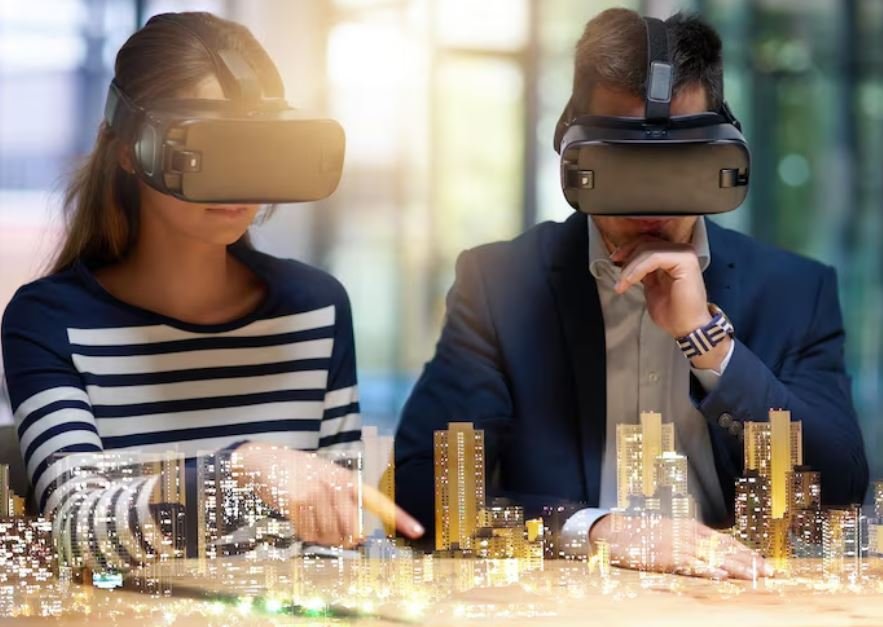
Although it may sound futuristic, owning digital property is fast emerging as one of the most talked-about investments of our day. Millions of dollars are being exchanged for properties that are nothing more than pixels and code, demonstrating that investors are treating virtual land with the same seriousness as they would premium urban real estate. Many visionaries, however, see this as a calculated step toward a new digital economy rather than as science fiction.
The introduction of blockchain-based ownership models by platforms such as Decentraland and The Sandbox sparked interest in virtual real estate. These platforms created NFTs—unique, verifiable assets that give users financial and creative control—from parcels of digital space. For avatars to visit, buyers can construct shops, museums, performance spaces, or even private islands. Previously intangible, it is now extremely profitable.
| Aspect | Description |
|---|---|
| Concept | Buying, selling, and developing digital property on blockchain-based platforms |
| Leading Platforms | Decentraland, The Sandbox, Somnium Space, Cryptovoxels |
| Ownership Type | NFTs (Non-Fungible Tokens) backed by blockchain verification |
| Primary Currencies | MANA, SAND, Ethereum |
| Early Investors | Snoop Dogg, Tokens.com, Gucci, Adidas, MetaCollective DAO |
| Record Purchase | $4.3 million for a plot in The Sandbox |
| Drivers of Value | Scarcity, brand presence, monetization opportunities |
| Potential Market Size | Projected $5 trillion by 2030 (McKinsey estimate) |
| Key Challenges | Market volatility, speculative risk, technical barriers |
| Reference | Time Magazine – “Why Investors Are Paying Real Money for Virtual Land” |
The boom in digital real estate picked up speed in 2021. By investing $1.7 million in a 50% share in Metaverse Group, a business that specializes in virtual land development, Tokens.com made headlines. The company immediately started building a posh digital district with Gucci, Burberry, and Louis Vuitton virtual boutiques. Staking a claim before the skyline is finished was an ambition that was remarkably similar to that of real estate developers in developing cities.
Shortly after, a $450,000 virtual plot next to Snoop Dogg’s digital mansion was bought by an unidentified buyer. The reasoning was similar to that of Beverly Hills real estate: fame increases value. Location-driven prestige is replicated digitally, but the neighborhood is located on a blockchain.
It was an instantaneous and powerful rush. In a single year, the price of virtual real estate increased by over 500%. Similar increases occurred in The Sandbox, where parcels that had previously sold for about $2,000 rose to over $35,000 at their peak. However, prices dropped precipitously—some by as much as 80%—when the market corrected. But there was still hope. Ten investors were quietly building, certain that the value of digital land would eventually rise again, for every critic who predicted a crash.
Belief, specifically the belief in scarcity, is what sustains this market. Digital platforms purposely restrict their land supply, much like beachfront real estate fetches high prices because it is scarce. Verified by blockchain, these boundaries produce artificial scarcity that works remarkably well. Virtual real estate has consequently evolved into a concrete representation of ownership in an area devoid of geographical restrictions.
Among the first to recognize the potential were brands. By charging more for virtual handbags than their real-life equivalents, Gucci’s “Gucci Garden” in Roblox showed how luxury could be translated into digital form. While Sotheby’s opened a metaverse gallery in Decentraland that welcomes thousands of visitors every day to view NFT art, Adidas set up a digital campus in The Sandbox. Every action demonstrated that virtual space was a new marketplace rather than just a novelty.
It has also caught the attention of analysts. According to McKinsey, the Metaverse’s total economic potential could reach $5 trillion by 2030, while Grayscale estimated that it could surpass $1 trillion. These projections highlight a unique feature of virtual real estate: it combines finance, entertainment, and technology in ways that traditional markets could never.
A new way of expressing oneself is also brought about by the growth of metaverse real estate. Digital land ownership is more than just an investment; it’s a means of establishing one’s identity. Virtual venues are used for weddings, business launches, and concert attendance. While major music festivals are investigating metaverse partnerships, Snoop Dogg has performed in his virtual estate. In this sense, property turns into a digital representation of who you are, much like a home does in real life.
The way that people view digital ownership is changing as a result of this change. The Metaverse offers personal spaces, which are specially created environments that are owned, created, and marketed by individuals, much like the early internet gave us personal websites. The analogy to the early internet is appropriate: domain names used to sell for pennies, but now they fetch millions of dollars. It’s possible that virtual land today will take a similar path, changing from speculative assets to necessary digital real estate.
However, there are some doubts about the landscape. According to billionaire investor Mark Cuban, metaverse land is “a bad bet,” since digital space has no inherent value. However, when Bitcoin and NFTs were still in their infancy, detractors made the same claims. Like any new market, the Metaverse has risks, but it also has incredible potential. Often, timing and vision make the difference.
Participation is more important than pixels in the real story. The appearance and functionality of these spaces are already being shaped by digital architects, designers, and programmers. Even virtual campuses are being developed by some universities, where students use avatars to attend classes. Virtual property owners are creating a new kind of digital society by fusing education, entertainment, and business.
Although the entry process is surprisingly simple for investors, technical knowledge is necessary. Through NFT marketplaces like OpenSea, buyers create cryptocurrency wallets, investigate popular virtual neighborhoods, and buy packages. Although they work at a digital pace, the strategic choices—location, visibility, and community involvement—are similar to those made in traditional real estate.
The growth is also being fueled by venture capital firms. For instance, to create an interactive learning center devoted to blockchain education, the MetaCollective DAO has acquired dozens of parcels in The Sandbox. Their objective is to demonstrate how metaverse property can benefit both the public and private sectors by fusing financial literacy with immersive experience.
What this new gold rush tells us about human ambition may be its most compelling feature. Land has always been sought after by people, not only for ownership but also for creation, connection, and belonging. With its limitless landscapes that are only constrained by the imagination, the Metaverse turns that instinct into a digital dimension.
Even though the market may change, the fundamental concept—a group effort to redefine ownership, value, and space in the digital age—seems timeless. The goal of owning virtual real estate is to expand reality rather than to escape it. It’s a different kind of frontier, where business and creativity coexist, and where the next generation of landowners is motivated by their imagination rather than geography.
